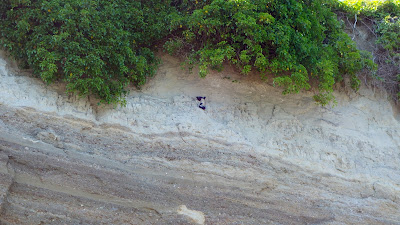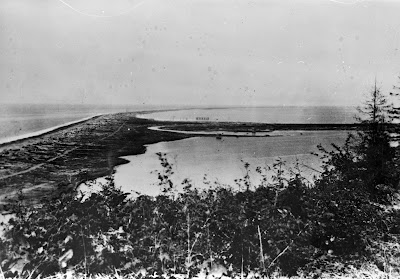Port Williams
is located on the Olympic Peninsula near Sequim, between Sequim Bay and New Dungeness Lighthouse. It’s currently a
Clallam County park with a boat ramp and wonderful beach combing opportunities. But in the late 1800s and into the early 1900s, this spot served as a port for Mosquito Fleet steamers that were providing supplies and transportation to the new settlers of the Sequim prairie. The wharf was built in 1890 and included a hotel, restaurant, post office, store and dance hall. The Port Williams townsite was abandoned in 1922.
 |
| Port Williams - Then (early 1900s) and Now (2020) |
The historic image is courtesy of the
Museum and Arts Center in Sequim-Dungeness. The exact date is unknown, but the ship, the
Alice Gertrude, was built in 1898 and
ended its run in Clallam Bay, running aground during a snowstorm in 1907.
It’s interesting to note the dark stripe that runs horizontally, halfway up the bluff in both photos. This is the result of glacio-lacustrine deposits, sediment that settled in glacial meltwater during the Vashon glaciation period. More than 14,000 years ago, the Cordilleran glacial ice sheet, measuring at least 3000 feet deep, covered most of Western Washington. As it advanced and retreated, the glacier carved much of Puget Sound into the landforms and waterways we see today. It also left us with timeless features to match up in
then and now photographs of our ever-eroding bluffs.
 |
| A better look at the different sediment layers in the bluff, with bonus pigeon guillemots! |
There are many other historic photographs of Port Williams to enjoy in the Bert Kellogg Collection, available for viewing on the
Washington Rural Heritage digital archive website or in person at the Port Angeles branch of the North Olympic Library System.










